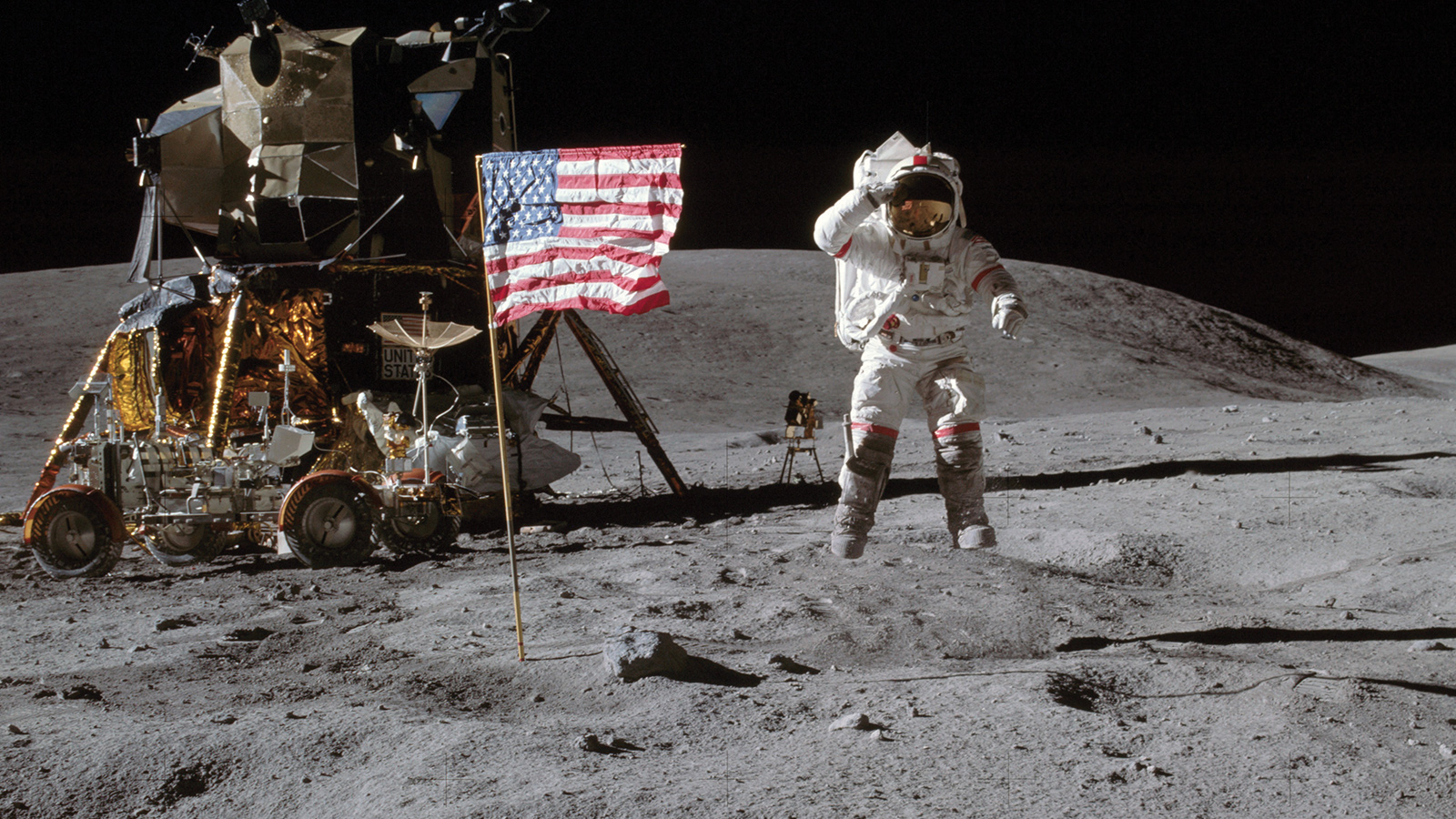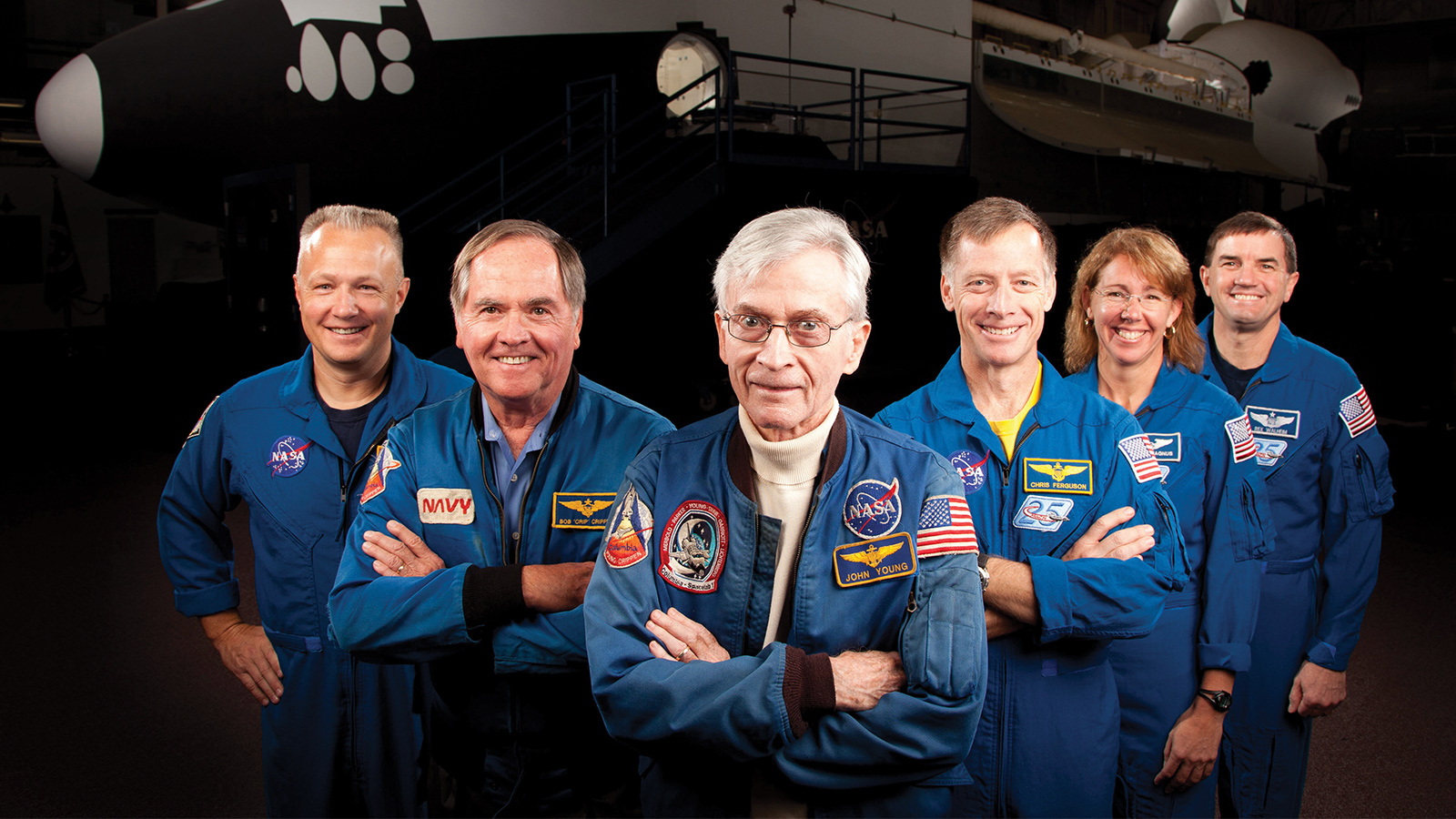Stay Up to Date
Submit your email address to receive the latest industry and Aerospace America news.
Astronaut John W. Young died at age 87 on Jan. 5. He was the ninth human to walk on the moon, flew six space missions, and served as an astronaut for over four decades. Veteran astronaut Tom Jones, who trained and flew (aircraft) with Young, remembers his personality and character.
When in 1996 NASA planted seven young live oak trees at Houston’s Johnson Space Center to memorialize the seven Challenger astronauts, lost in flight 10 years earlier, its most senior astronaut, John Young, advised his younger colleagues to show up at the ceremony. “Y’all better go — you’re all going to have a tree of your own out there someday.”
In May, John’s sturdy oak was dedicated at Johnson’s Astronaut Memorial Grove, its base blanketed by red roses laid in tribute by the astronaut corps. A T-38 rocketed upward from its four-ship “missing man” formation (see video below) in a final, fitting salute to the legendary test pilot and astronaut.
John was NASA’s longest-serving astronaut, with 42 years in service to the U.S. space agency. He is unquestionably one of the top flyers ever to have piloted an American spacecraft. He launched into space six times — seven, if you count his Apollo 16 blastoff from the moon. For nearly two decades as NASA’s senior astronaut, he employed a watchful eye and insistent voice to enhance astronaut safety.
The highlights of John’s career are well-known. He served in the Korean War as a fire control officer aboard a destroyer, then trained as a naval aviator and test pilot. In 1962, he set two world time-to-climb records in the powerful McDonnell F-4 Phantom 2 interceptor. Hired with NASA’s second group of astronauts in 1962, John flew as Gus Grissom’s pilot on the first Gemini mission in 1965. Gemini 3 was aloft for only three orbits, but John and Gus demonstrated the spacecraft’s ability to change its orbit, essential for later Apollo rendezvous maneuvers around the moon. During the flight, John famously surprised Gus with a corned beef sandwich he had stashed in his spacesuit pocket, a treat enjoyed by Gus but blasted as a possible safety risk by a few humorless congressmen.
John commanded Gemini 10, and with Mike Collins docked with an Agena target spacecraft, another critical test for Apollo. In 1969, he flew as Apollo 10’s command module pilot on a successful lunar orbit rehearsal for Apollo 11’s historic first landing two months later.
He voyaged again to the moon (one of only three humans to do so twice) as commander of Apollo 16, landing in the Descartes highlands with Charlie Duke in April 1972. During their first moonwalk, the pair learned that the U.S. House had approved funds for NASA’s planned space shuttle. From the moon, Young radioed, “The country needs that shuttle mighty bad.”
John would command the first space shuttle mission, STS-1, on orbiter Columbia in April 1981 — in my opinion, his crowning career achievement. It was the first time — before or since — that a new spacecraft was launched carrying astronauts on its first voyage. Roaring skyward on the untried shuttle “stack” — external tank, boosters and orbiter — Young and pilot Bob Crippen orbited Earth 36 times and flew Columbia to a perfect touchdown at Edwards Air Force Base, California. The pair’s skill and courage were central to the success of what NASA acclaimed as “the boldest test flight in history.”
John’s final spaceflight saw him command STS-9, Columbia, in 1983, a mission to carry the first European-built Spacelab module in the orbiter’s cargo bay. The crew overcame two flight computer failures and a fire in two of three auxiliary power units driving their aero-surface hydraulic systems. Columbia landed safely after 10 days. Later, Young said, “We didn’t know it was on fire. We had no idea. Fact is we landed on Thursday and found out about the fire on Saturday — so that’s the kind of fire to have.”
That was “John Young cool.”
Cool, I saw first-hand, did not mean oblivious to risk.
From 1974 until 1987, John served as chief of the Astronaut Office. Piloting a NASA training jet over Cape Canaveral, he witnessed the shuttle Challenger’s catastrophic breakup on Jan. 28, 1986. In an internal memo written before the accident, Young warned, “If we do not consider Flight Safety first all the time at all levels of NASA, this machinery and this program will NOT make it.” When the memo leaked to the press in March 1986, the resulting uproar led NASA a year later to reassign him as technical adviser to the director of Johnson Space Center.
The loss of seven of “his” astronauts caused Young to redouble his focus on crew safety. Astronaut Alvin Drew remembers Young saying: “The number one job of any astronaut is to keep any other astronaut from getting killed.” John continued to write memos — I still have at least three dozen — to the astronauts, Space Center, and headquarters management suggesting design and operational upgrades to improve shuttle safety. Budget limitations kept many of his hardware fixes from implementation, but his innovative ideas for expanding the shuttle’s launch abort and emergency landing options eventually became reality.
When I became an astronaut candidate in 1990, John in his role as special assistant to the director was a regular at our Monday morning staff meetings. He sat quietly off to the left of the chief’s table as the astronauts discussed the week’s issues, including ongoing flight preparations, tests and safety questions. We could always count on his laconic commentary on NASA’s progress (or lack thereof) in meeting those challenges. He didn’t say much, but his words were reliably memorable. He always softened a probing question by adding in his apologetic drawl: “Just askin’.”
We astronaut candidates were sometimes lucky enough to draw Young as commander in a shuttle simulator session. No shuttle malfunction or tight corner of the flight envelope fazed him, but once, during a simulated ride to orbit, one of my classmates, the flight engineer, deliberately (and on the sly) shut down one of our main engines. The failure forced John to finesse an emergency abort landing into Morocco. I was aghast, worried that my classmate’s practical joke had gone too far; one word from Young and neither he nor I would ever fly in space. But when the gag was revealed, John loved it; a “good one,” he said. We came away hopeful that John’s tutelage would help us someday strap into the seat of a real shuttle. We came away admiring his ability to laugh with us novices as much as his sure hand at the controls.
Every few weeks I’d answer the phone at my desk and hear a familiar drawl. “Hey, ol’ buddy, this is John Young. Want to go fly to the Cape tomorrow? We’ll go kick the tires on an orbiter.”
Well, John called everybody “ol’ buddy,” but his invitation was nevertheless a genuine compliment. We’d streak from Houston’s Ellington Field in a NASA T-38, soar across the Gulf of Mexico, and touch down at Kennedy Space Center’s shuttle landing runway. We’d hop in a van and 15 minutes later be checking out a real space shuttle in its hangar. Any chance to get close to a shuttle was a privilege, but to do it with John Young? Priceless.
Flying home into the sunset at flight level 380, I’d nudge John from the back seat: What was it like to live on the moon? “Well, for one thing, being able to pour water into a cup in one-sixth G sure beats free fall any day.” These flights offered spaceflight readiness training along with a critique of NASA operations or exploration plans, delivered by a man who’d lived it all, from triumph to tragedy.
Young left NASA in 2004, but even after retirement, he continued to write and speak about everything from the nation’s need for heavy lift launchers, to the value of the moon in a space economy, to the challenges of protecting the planet from rogue asteroids. Young believed in safety, yes, but he also believed we must explore. Know the risks, work to safeguard the astronauts, but keep pushing outward.
John Young was a pilot, engineer, astronaut and explorer, a Renaissance (space)man, you might say. He wrote in his memoir that he considered his space experiences a marvel. John concluded, “I just want those marvels to continue for the next generations.”
Photo at the top of the story: After the final space shuttle mission, the crews of STS-1 and STS-135, the first and last missions, gathered in 2011 at NASA’s Johnson Space Center. John Young, STS-1 commander, center, was joined by, from left, STS-135 pilot Doug Hurley, STS-1 pilot Robert Crippen, STS-135 commander Chris Ferguson, and mission specialists Sandy Magnus and Rex Walheim. Magnus is the former executive director of AIAA. Credit: NASA photo/Houston Chronicle, Smiley N. Pool.
“The number one job of any astronaut is to keep any other astronaut from getting killed.”
John Young, as remembered by astronaut Alvin Drew
About Tom Jones
Tom flew on four space shuttle missions, including his last flight, STS-98, in which he led three spacewalks to install the American Destiny laboratory on the International Space Station. Tom is a senior research scientist at the Florida Institute for Human and Machine Cognition.
Related Posts
Stay Up to Date
Submit your email address to receive the latest industry and Aerospace America news.







